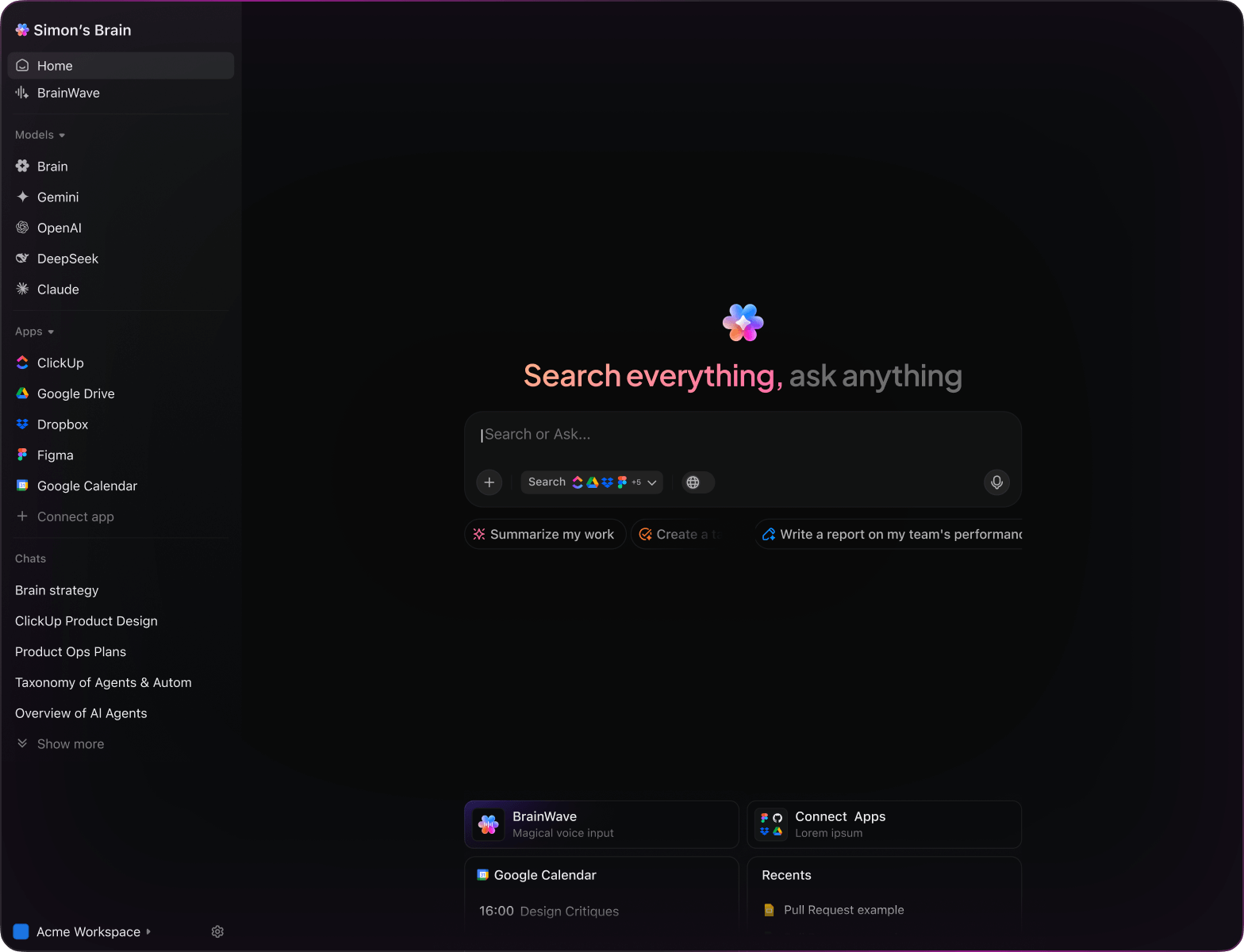AI Dialogue Crafting
Top AI Prompts for Dialogue Writing
Elevate your scriptwriting, organize conversations effortlessly, and bring characters to life with ClickUp Brain.
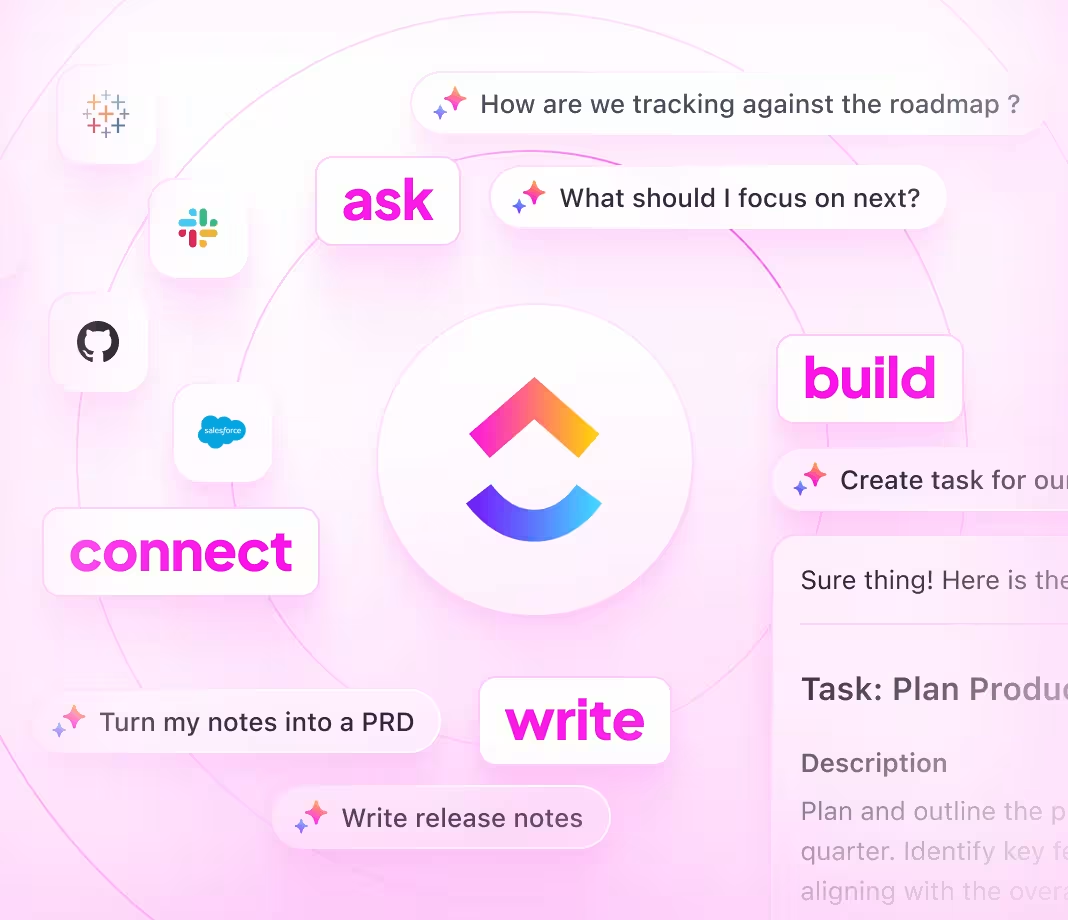
Trusted by the world’s leading businesses
AI for Dialogue Creators
Revolutionizing Dialogue Writing with AI Prompts in ClickUp Brain
Crafting compelling conversations goes beyond just words on a page—it’s about shaping authentic interactions that resonate.
From character development to scene pacing and emotional tone, dialogue writing demands juggling multiple elements—and countless revisions and notes. That’s why AI prompts are becoming indispensable.
Writers and teams leverage AI to:
- Quickly generate context-aware dialogue suggestions
- Outline character voices and conversational flows with ease
- Analyze tone and emotional consistency across scenes
- Transform scattered ideas into organized scripts, dialogue trees, or task lists
Integrated into familiar tools—like docs, brainstorming boards, and project trackers—AI in ClickUp Brain acts as a creative partner, turning raw dialogue drafts into polished, actionable writing tasks.
ClickUp Brain Compared to Conventional AI
Discover Why ClickUp Brain Stands Out
ClickUp Brain integrates seamlessly with your workflow, reducing setup time and boosting focus on writing.
Conventional AI Solutions
- Constantly toggling between apps to collect background info
- Reiterating your objectives with every input
- Responses that lack relevance to your dialogue context
- Hunting through multiple platforms for a single script
- Interacting with AI that doesn't engage actively
- Manually switching among different AI engines
- Merely a browser add-on without deep integration
ClickUp Brain
- Deeply connected to your scripts, notes, and team feedback
- Retains your project history and writing style
- Provides insightful, context-driven suggestions
- Centralized search across all your dialogue assets
- Supports hands-free input with Talk to Text
- Automatically selects the optimal AI model: GPT, Claude, Gemini
- Dedicated desktop app for Mac & Windows optimized for performance
Dialogue Writing Prompts
15 Essential AI Prompts for Dialogue Writing
Enhance your scriptwriting—character development, tone, and flow simplified.

List 5 distinct dialogue approaches for a high-stakes negotiation between two rivals, inspired by the ‘Conflict Dynamics’ doc.
ClickUp Brain Behavior: Analyzes tone and character notes from the linked document to propose varied conversational styles.

What dialogue patterns are currently popular in contemporary drama scripts under 30 pages?
ClickUp Brain Behavior: Gathers insights from internal script analyses; Brain Max can supplement with public script databases if accessible.

Create a structured dialogue outline for a reunion scene focusing on emotional depth, referencing ‘Scene Breakdown #12’ and previous notes.
ClickUp Brain Behavior: Extracts relevant emotional cues and narrative points from linked files to build a comprehensive dialogue plan.

Summarize differences in dialogue pacing between ‘Script A’ and ‘Script B’ using our ‘Pacing Analysis Q1’ doc.
ClickUp Brain Behavior: Extracts timing and flow data from internal documents and delivers a concise comparative summary.

Identify top phrases and idioms that add realism to characters in contemporary urban dramas, referencing dialogue samples and style guides.
ClickUp Brain Behavior: Reviews internal dialogue examples and style notes to compile a list of authentic language elements.

From the ‘Series Continuity’ doc, produce a checklist ensuring character voice and tone remain consistent throughout episodes.
ClickUp Brain Behavior: Detects key consistency criteria and formats them into an actionable checklist within a task or document.

Outline three notable dialogue trends in recent sci-fi scripts based on post-2023 research and script review documents.
ClickUp Brain Behavior: Identifies recurring themes and stylistic patterns from linked research and script notes.

From the ‘Audience Feedback Q2’ doc, summarize key preferences related to dialogue style and humor in romantic comedies.
ClickUp Brain Behavior: Analyzes survey data and feedback to pinpoint favored dialogue characteristics and comedic timing.

Craft witty and concise dialogue lines for a lighthearted scene using the tone guidelines in ‘ComedyVoice.pdf’.
ClickUp Brain Behavior: Extracts tone and style cues from the document and proposes varied dialogue options fitting the comedic mood.

Outline recent content guidelines impacting dialogue in televised dramas, referencing the ‘Broadcast Standards 2025’ doc.
ClickUp Brain Behavior: Condenses compliance documents and highlights key points affecting scriptwriting practices.

Using internal formatting guides, create a set of rules for positioning dialogue tags and action lines in screenplay scripts.
ClickUp Brain Behavior: Extracts formatting standards from documents to produce a clear, structured guideline checklist.

From ‘Emotional Arc Guidelines’ and script folders, develop a checklist ensuring key emotional moments are effectively conveyed through dialogue.
ClickUp Brain Behavior: Identifies critical emotional markers and organizes them into a practical checklist for writers.

Analyze how subtext is employed in dialogue within thriller, drama, and comedy scripts using our genre analysis docs.
ClickUp Brain Behavior: Summarizes findings into an accessible format highlighting differences and techniques.

What dialogue styles are emerging in VR narratives since 2023?
ClickUp Brain Behavior: Synthesizes trends from internal reports, concept notes, and uploaded VR script samples.

Extract and prioritize viewer feedback on dialogue clarity and cultural nuances from the ‘Global Audience Feedback’ folder.
ClickUp Brain Behavior: Analyzes survey responses and comments to highlight common issues and improvement areas.
Create Dialogue Effortlessly with ClickUp Brain
Cut down revisions, unify your team’s vision, and craft compelling conversations using AI-enhanced workflows.





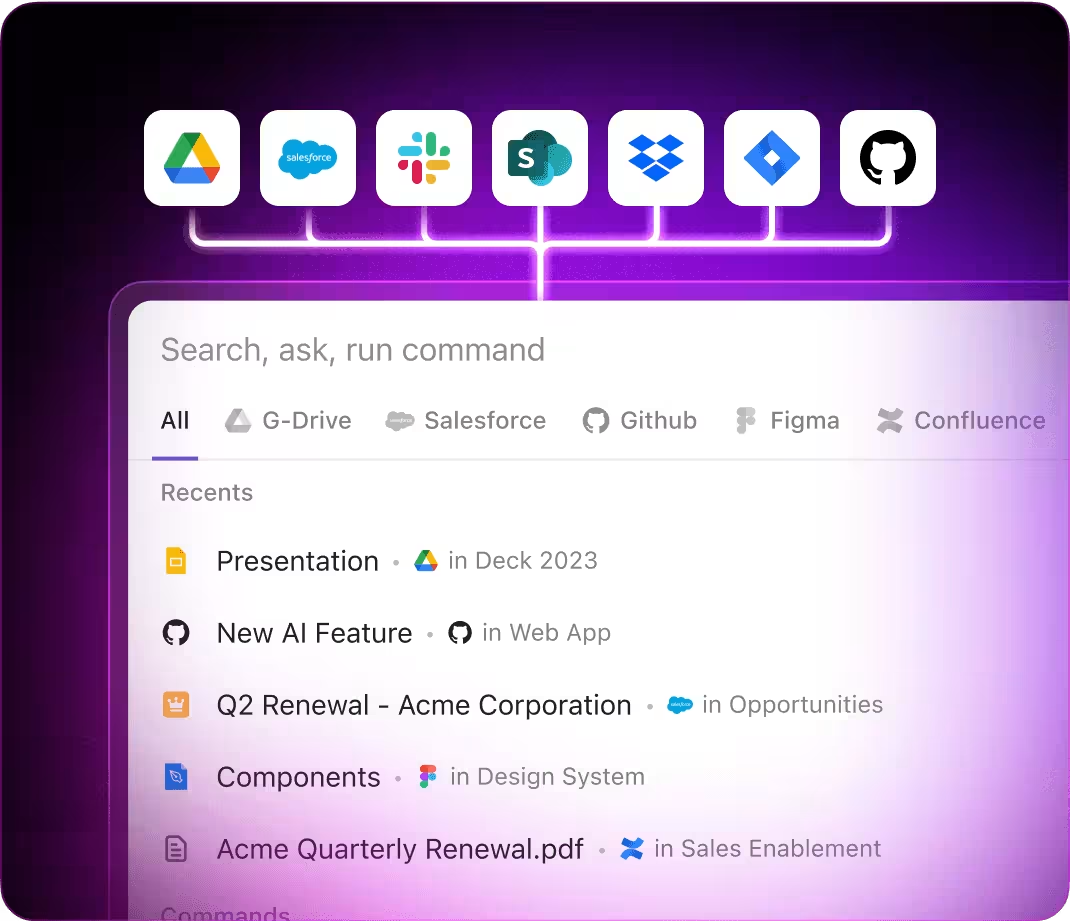
LLMs vs. Workflow Intelligence: How ClickUp Brain Enhances Dialogue Writing
Discover How ChatGPT, Gemini, Perplexity, and ClickUp Brain Support Creative Conversation Development
ChatGPT Dialogue Writing Prompts
- Outline a 5-point character profile focusing on motivations and conflicts for a new dialogue scene.
- Compose engaging opening lines for a dramatic exchange between two protagonists.
- Suggest 3 alternative emotional tones for a negotiation scene and explain their impact.
- Develop a stepwise plan for scripting a multi-turn dialogue that reveals backstory naturally.
- Compare dialogue styles from three classic plays and summarize key techniques for authentic voice.
Gemini Conversation Design Prompts
- Propose 3 different dialogue flow structures for a customer support chatbot scenario.
- List innovative ways to incorporate humor into character interactions while maintaining plot coherence.
- Create a mood board description for a tense courtroom exchange, highlighting pacing, tone, and language.
- Recommend seating arrangements and body language cues for a virtual role-play session to enhance realism.
- Build a comparison chart for dialogue pacing techniques in comedy, drama, and thriller genres.
Perplexity Dialogue Insights Prompts
- Identify 5 effective rhetorical devices for persuasive dialogue and rank by audience engagement.
- Compare conversational styles in popular podcasts, focusing on clarity, tone, and listener retention.
- Summarize global trends in interactive storytelling and their influence on dialogue writing.
- Generate a list of 5 creative conflict scenarios for dialogue-driven narratives and rank by dramatic potential.
- Analyze past script excerpts and highlight top 3 lessons for crafting natural-sounding conversations.
ClickUp Brain Dialogue Writing Prompts
- Transform this brainstorming session transcript into clear writing tasks with assigned deadlines.
- Summarize feedback from script readings and create follow-up action items for dialogue refinement.
- Review annotated dialogue drafts and generate a checklist of revisions needed for character consistency.
- Compile a task list from team discussions on scene pacing improvements, including priority tags.
- Summarize user feedback on dialogue flow tests and produce actionable editing and bug-fix tasks in ClickUp.
How ClickUp Supports You
Shape Your Dialogue Ideas into Polished Scripts
- Transform scattered thoughts into clear dialogue outlines swiftly.
- Generate new character interactions inspired by previous conversations.
- Build customizable templates that accelerate scriptwriting workflows.
Brain Max Boost: Quickly access past dialogues, notes, and feedback to fuel your next script development.
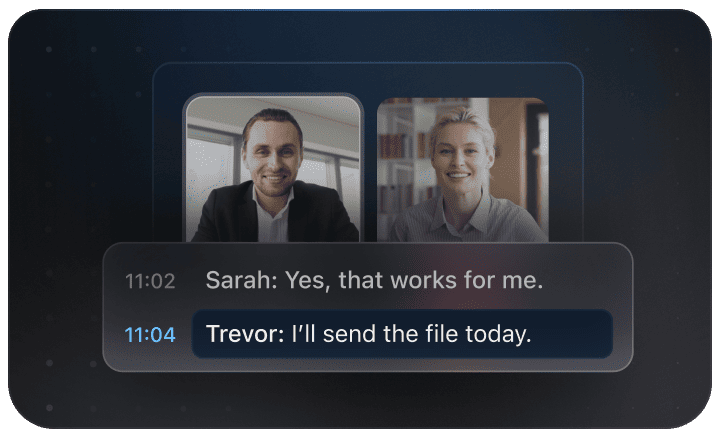
Why Choose ClickUp
Accelerate Dialogue Writing Workflows
- Break down intricate conversations into manageable writing tasks.
- Transform brainstorming notes into structured dialogue scenes.
- Instantly create summaries and character arcs without extra effort.
Brain Max Boost: Retrieve previous dialogue versions, character traits, or plot points swiftly across your projects.
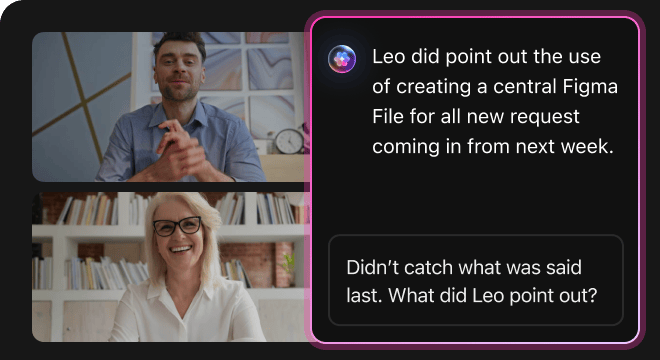
AI Advantages
How AI Prompts Elevate Every Phase of Dialogue Writing
AI prompts accelerate creativity and inspire more engaging, authentic conversations.
Create Engaging Dialogue Ideas Quickly
Writers explore fresh conversational angles rapidly, enhance character voices, and overcome writer’s block.
Enhance Narrative Flow and Clarity
Craft clearer exchanges, deepen character interactions, and ensure conversations feel natural and impactful.
Spot Inconsistencies Early
Identifies dialogue issues before revisions pile up, improving story coherence and saving editing time.
Align Writing Teams Effortlessly
Facilitates shared understanding, reduces miscommunication, and accelerates consensus among authors and editors.
Inspire Original and Memorable Conversations
Generates unique dialogue twists, enriches character development, and keeps readers captivated.
Integrated Directly Within ClickUp
Transforms AI suggestions into actionable tasks, keeping your dialogue projects moving forward smoothly.
Boost Your Dialogue Creation
Minimize mistakes, enhance collaboration, and craft richer conversations with AI support.





